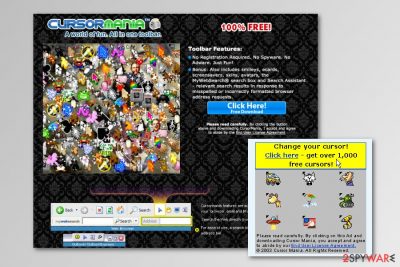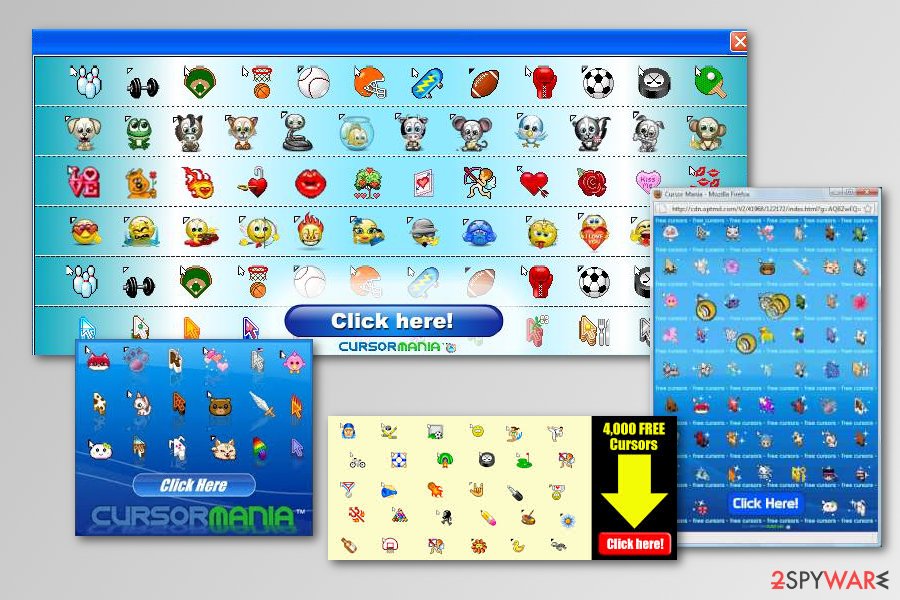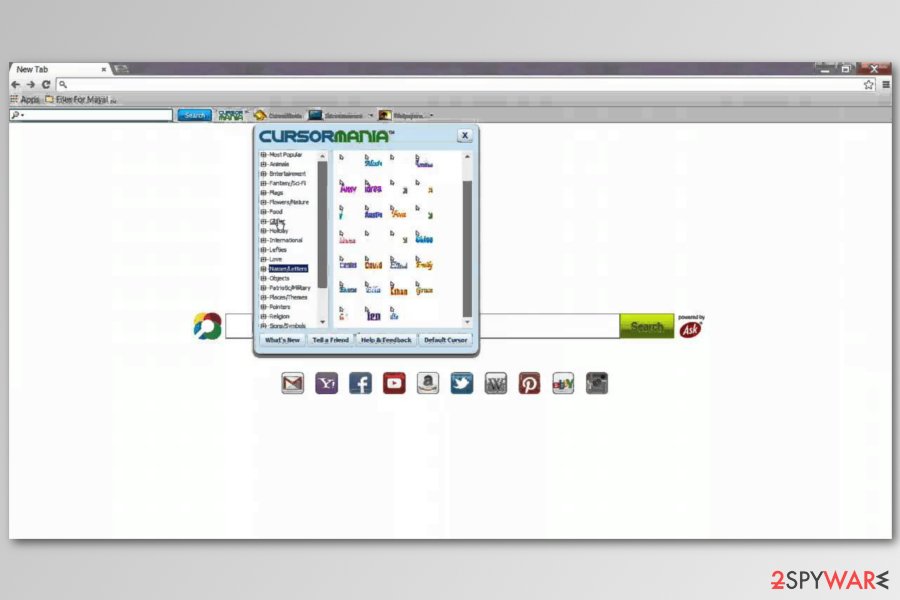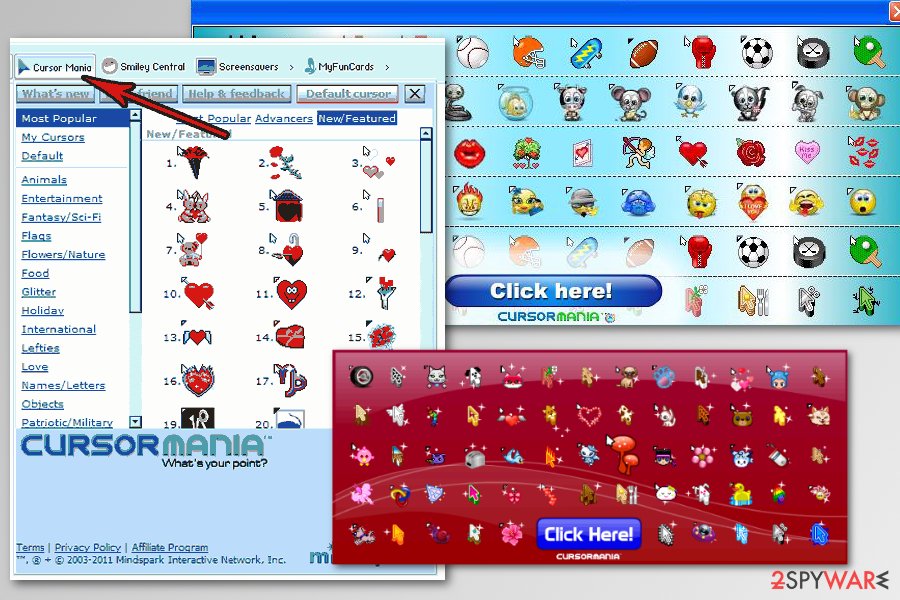Cursor Mania (Tutorial) - Jan 2021 update
Cursor Mania Removal Guide
What is Cursor Mania?
Cursor Mania – a toolbar that can alter browser's settings and connect your machine to a botnet

Cursor Mania is a potentially unwanted program (PUP)[1] created by Mindspark Interactive. The program operates as adware but also has features of the browser hijacker. Moreover, it might operate as a trojan[2] on Internet Explorer and Opera browsers. The application was very active for more than a decade. However, since 2013 is no longer available to download from the official site.
| Summary of the cyber threat | |
|---|---|
| Name | Cursor Mania |
| Release date | 2000s |
| The end of official distribution | 2013 |
| Developers | Mindspark Interactive |
| Type | Adware |
| Affected OS | Windows |
| Targeted browsers | Google Chrome, Mozilla Firefox, Internet Explorer, Opera |
| Symptoms | Replaced homepage/search engine, installation of unknown toolbars, redirects to questionable sites, an increased amount of ads |
| Distribution | Software bundling |
| Uninstall | Use manual instructions below or employ anti-malware software for automatic removal |
| Don't forget to clean your browsers – you can use FortectIntego to do it quickly | |
Cursor Mania is presented as a toolbar that allows changing the icon of your mouse cursor. This might seem like a fun feature that lets changing your ordinary mouse pointer to an animal or sword. However, this application also changes some browser settings. However, developers described it as bonus features:
Also includes smileys, ecards, screensavers, skins, avatars, the MyWebSearch search box and Search Assistant – relevant search results in response to misspelled or incorrectly formatted browser address requests.
However, all these activities and modifications on the browser might show up out of nowhere. This might happen due to the distribution method. The app was actively distributed via software bundling that allows infiltrating the system unnoticed when uses incorrectly download freeware or shareware. However, soon after the installation, it makes some changes to the system and creates the Cursormania.exe process in the Windows Task Manager.

This virus might hijack Google Chrome, Mozilla Firefox, Internet Explorer, and Opera web browsers and cause the following problems:
- changing browser’s default homepage/default search engine to MyWebSearch;
- installs the toolbar and many other additional plugins, extensions, and toolbars;
- displays intrusive ads and pop-ups;
- promotes questionable software, toolbars or updates.
All of these changes slow down the browser and cannot be reverted by the users. This PUP operates in a way that all user’s attempts to change the default search engine or homepage are rejected. Hence, every time you open the browser after the system reboot, the unwanted search engine and toolbars might reappear again.

CursorMania is also known as a toolbar trojan that might cause different effects on the browsers installed on Windows OS. When it hijacks Internet Explorer or Opera, it can connect users to the botnet[3] called DragonDog. Then affected browser’s homepage is set to a fake website, for instance, Facebook or YouTube. These bogus pages look identical to the original ones, so unsuspecting victims might reveal their login details to cybercriminals.
Just like many other adware programs, the app might also collect various information about users.[4] It may start tracking your browsing on the web and may collect your search terms, most visited websites, data that you enter when visiting your favorite sites, your email address, computer's IP address, its location, etc. While you may think that this information can't be used for dangerous activities, it can.
All the aggregated details might be used for displaying appealing and encouraging ads or shared with unknown third parties. To avoid clicking on potentially dangerous ads or redirecting to a tech support scam[5] or malware-related website, you need to get rid of this toolbar.

We highly recommend opting for automatic adware removal and terminate all adware-related components within a few clicks. You will need to obtain SpyHunter 5Combo Cleaner or another reputable anti-malware software for this task.
Of course, you can do the job yourself. If you are willing to remove Cursor Mania manually, you should find our elimination instructions handy. Do not forget to check all browsers installed (you can also do that automatically with FortectIntego) on your PC and uninstall all related apps from your Windows machine.

Adware hijack might occur during careless freeware or shareware installation
This potentially unwanted program was available to download on its official website. However, the site is shut down for a couple of years. Though, direct downloads have never been the major distribution method.
Such programs typically spread bundled with freeware and shareware. Hence, if you do not pay attention to the installation process, you can install unwanted toolbars and agree to change your default search engine. To avoid that, you should follow the security tips prepared by NoVirus.uk[4] security team:
- Always use reliable downloads sources for software. Do not use third-party file-sharing sites or P2P networks.
- Download apps only from trusted developers.
Read Terms of Use and Privacy Policy before installing applications. If these documents are not provided, quit the - procedure.
- Use Advanced/Custom settings instead of Quick/Standard because the latter ones do not reveal what additional downloads might be included in the same software package.
- Follow the installation wizard attentively and opt out all pre-selected additional downloads.
Uninstall guide
To remove Cursor Mania from your Windows computer entirely, you have two options: manual and automatic elimination. The latter one is definitely easier. It requires only scanning the device with anti-malware software and resetting affected browsers.
Automatic PUP removal is recommended because PUP usually arrives in the system together with other undesired apps. Hence, you need to clean all of these entries to stop redirects, pop-ups, and other unwanted activities on the browser.
However, you can still uninstall the app manually. As you may have figured out, you will need to search for and delete other PUP-related components from Windows and each of the browser. Please, follow our guide attentively. In case of the failure, please switch to the automatic elimination method.
You may remove virus damage with a help of FortectIntego. SpyHunter 5Combo Cleaner and Malwarebytes are recommended to detect potentially unwanted programs and viruses with all their files and registry entries that are related to them.
Getting rid of Cursor Mania. Follow these steps
Uninstall from Windows
Instructions for Windows 10/8 machines:
- Enter Control Panel into Windows search box and hit Enter or click on the search result.
- Under Programs, select Uninstall a program.

- From the list, find the entry of the suspicious program.
- Right-click on the application and select Uninstall.
- If User Account Control shows up, click Yes.
- Wait till uninstallation process is complete and click OK.

If you are Windows 7/XP user, proceed with the following instructions:
- Click on Windows Start > Control Panel located on the right pane (if you are Windows XP user, click on Add/Remove Programs).
- In Control Panel, select Programs > Uninstall a program.

- Pick the unwanted application by clicking on it once.
- At the top, click Uninstall/Change.
- In the confirmation prompt, pick Yes.
- Click OK once the removal process is finished.
Delete from macOS
Remove items from Applications folder:
- From the menu bar, select Go > Applications.
- In the Applications folder, look for all related entries.
- Click on the app and drag it to Trash (or right-click and pick Move to Trash)

To fully remove an unwanted app, you need to access Application Support, LaunchAgents, and LaunchDaemons folders and delete relevant files:
- Select Go > Go to Folder.
- Enter /Library/Application Support and click Go or press Enter.
- In the Application Support folder, look for any dubious entries and then delete them.
- Now enter /Library/LaunchAgents and /Library/LaunchDaemons folders the same way and terminate all the related .plist files.

Remove from Microsoft Edge
Delete unwanted extensions from MS Edge:
- Select Menu (three horizontal dots at the top-right of the browser window) and pick Extensions.
- From the list, pick the extension and click on the Gear icon.
- Click on Uninstall at the bottom.

Clear cookies and other browser data:
- Click on the Menu (three horizontal dots at the top-right of the browser window) and select Privacy & security.
- Under Clear browsing data, pick Choose what to clear.
- Select everything (apart from passwords, although you might want to include Media licenses as well, if applicable) and click on Clear.

Restore new tab and homepage settings:
- Click the menu icon and choose Settings.
- Then find On startup section.
- Click Disable if you found any suspicious domain.
Reset MS Edge if the above steps did not work:
- Press on Ctrl + Shift + Esc to open Task Manager.
- Click on More details arrow at the bottom of the window.
- Select Details tab.
- Now scroll down and locate every entry with Microsoft Edge name in it. Right-click on each of them and select End Task to stop MS Edge from running.

If this solution failed to help you, you need to use an advanced Edge reset method. Note that you need to backup your data before proceeding.
- Find the following folder on your computer: C:\\Users\\%username%\\AppData\\Local\\Packages\\Microsoft.MicrosoftEdge_8wekyb3d8bbwe.
- Press Ctrl + A on your keyboard to select all folders.
- Right-click on them and pick Delete

- Now right-click on the Start button and pick Windows PowerShell (Admin).
- When the new window opens, copy and paste the following command, and then press Enter:
Get-AppXPackage -AllUsers -Name Microsoft.MicrosoftEdge | Foreach {Add-AppxPackage -DisableDevelopmentMode -Register “$($_.InstallLocation)\\AppXManifest.xml” -Verbose

Instructions for Chromium-based Edge
Delete extensions from MS Edge (Chromium):
- Open Edge and click select Settings > Extensions.
- Delete unwanted extensions by clicking Remove.

Clear cache and site data:
- Click on Menu and go to Settings.
- Select Privacy, search and services.
- Under Clear browsing data, pick Choose what to clear.
- Under Time range, pick All time.
- Select Clear now.

Reset Chromium-based MS Edge:
- Click on Menu and select Settings.
- On the left side, pick Reset settings.
- Select Restore settings to their default values.
- Confirm with Reset.

Remove from Mozilla Firefox (FF)
Follow these steps to delete unwanted extensions from Mozilla Firefox:
Remove dangerous extensions:
- Open Mozilla Firefox browser and click on the Menu (three horizontal lines at the top-right of the window).
- Select Add-ons.
- In here, select unwanted plugin and click Remove.

Reset the homepage:
- Click three horizontal lines at the top right corner to open the menu.
- Choose Options.
- Under Home options, enter your preferred site that will open every time you newly open the Mozilla Firefox.
Clear cookies and site data:
- Click Menu and pick Settings.
- Go to Privacy & Security section.
- Scroll down to locate Cookies and Site Data.
- Click on Clear Data…
- Select Cookies and Site Data, as well as Cached Web Content and press Clear.

Reset Mozilla Firefox
If clearing the browser as explained above did not help, reset Mozilla Firefox:
- Open Mozilla Firefox browser and click the Menu.
- Go to Help and then choose Troubleshooting Information.

- Under Give Firefox a tune up section, click on Refresh Firefox…
- Once the pop-up shows up, confirm the action by pressing on Refresh Firefox.

Remove from Google Chrome
This guide will help you to locate adware-related components and remove them from Google Chrome:
Delete malicious extensions from Google Chrome:
- Open Google Chrome, click on the Menu (three vertical dots at the top-right corner) and select More tools > Extensions.
- In the newly opened window, you will see all the installed extensions. Uninstall all the suspicious plugins that might be related to the unwanted program by clicking Remove.

Clear cache and web data from Chrome:
- Click on Menu and pick Settings.
- Under Privacy and security, select Clear browsing data.
- Select Browsing history, Cookies and other site data, as well as Cached images and files.
- Click Clear data.

Change your homepage:
- Click menu and choose Settings.
- Look for a suspicious site in the On startup section.
- Click on Open a specific or set of pages and click on three dots to find the Remove option.
Reset Google Chrome:
If the previous methods did not help you, reset Google Chrome to eliminate all the unwanted components:
- Click on Menu and select Settings.
- In the Settings, scroll down and click Advanced.
- Scroll down and locate Reset and clean up section.
- Now click Restore settings to their original defaults.
- Confirm with Reset settings.

Delete from Safari
Remove unwanted extensions from Safari:
- Click Safari > Preferences…
- In the new window, pick Extensions.
- Select the unwanted extension and select Uninstall.

Clear cookies and other website data from Safari:
- Click Safari > Clear History…
- From the drop-down menu under Clear, pick all history.
- Confirm with Clear History.

Reset Safari if the above-mentioned steps did not help you:
- Click Safari > Preferences…
- Go to Advanced tab.
- Tick the Show Develop menu in menu bar.
- From the menu bar, click Develop, and then select Empty Caches.

After uninstalling this potentially unwanted program (PUP) and fixing each of your web browsers, we recommend you to scan your PC system with a reputable anti-spyware. This will help you to get rid of Cursor Mania registry traces and will also identify related parasites or possible malware infections on your computer. For that you can use our top-rated malware remover: FortectIntego, SpyHunter 5Combo Cleaner or Malwarebytes.
How to prevent from getting adware
Stream videos without limitations, no matter where you are
There are multiple parties that could find out almost anything about you by checking your online activity. While this is highly unlikely, advertisers and tech companies are constantly tracking you online. The first step to privacy should be a secure browser that focuses on tracker reduction to a minimum.
Even if you employ a secure browser, you will not be able to access websites that are restricted due to local government laws or other reasons. In other words, you may not be able to stream Disney+ or US-based Netflix in some countries. To bypass these restrictions, you can employ a powerful Private Internet Access VPN, which provides dedicated servers for torrenting and streaming, not slowing you down in the process.
Data backups are important – recover your lost files
Ransomware is one of the biggest threats to personal data. Once it is executed on a machine, it launches a sophisticated encryption algorithm that locks all your files, although it does not destroy them. The most common misconception is that anti-malware software can return files to their previous states. This is not true, however, and data remains locked after the malicious payload is deleted.
While regular data backups are the only secure method to recover your files after a ransomware attack, tools such as Data Recovery Pro can also be effective and restore at least some of your lost data.
- ^ Chris Hoffman. PUPs Explained: What is a “Potentially Unwanted Program”?. How-To Geek. The website explains technology.
- ^ Vangie Beal. Trojan horse. Online Tech dictionary for IT professionals.
- ^ Josh Fruhlinger. The Mirai botnet explained: How teen scammers and CCTV cameras almost brought down the internet. CSO. Security news, features and analysis.
- ^ No Virus. No Virus. Cyber security and spyware news.
- ^ Lee Mathews. Windows Tech Support Scams Continue To Be A Global Menace. Forbes. The magazine about business, investing, technology, entrepreneurship, leadership, and lifestyle.























